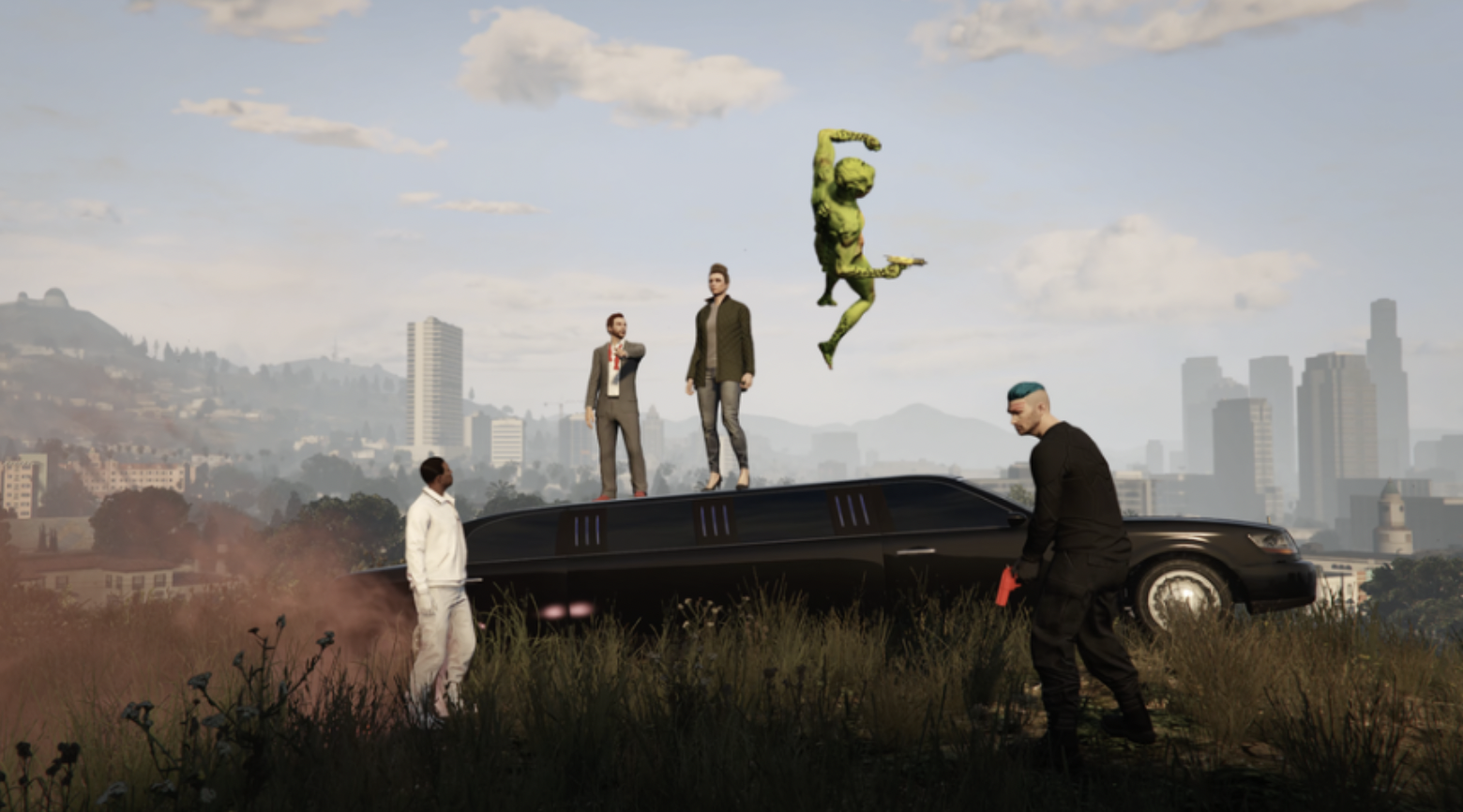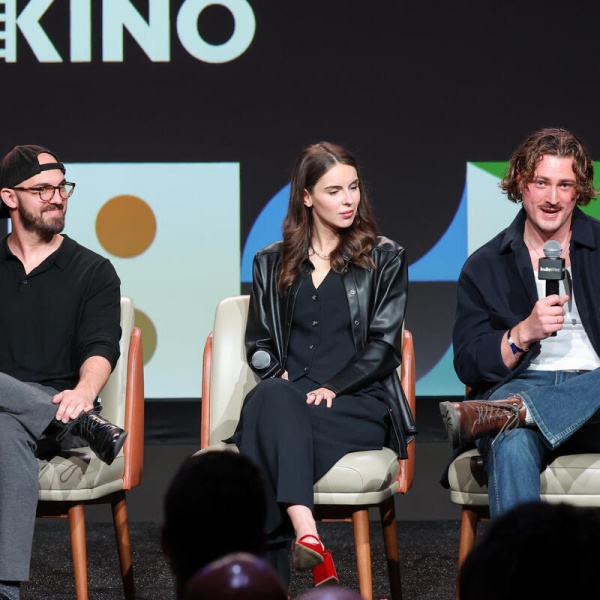For all of the artistic challenges posed by filming an entire documentary inside a video game, you’d think that it would at least be a lighter logistical lift for filmmakers. There’s no need to acquire permits, haul heavy equipment to remote locations, or wrangle large film crews. But when Sam Crane and Pinny Grylls decided to stage a production of “Hamlet” inside of “Grand Theft Auto Online” during the final months of the COVID-19 pandemic and make a documentary about the experience, they quickly found that making art inside of the game was more complicated than it looks. The biggest challenge? Convincing online strangers playing the famously violent game not to shoot them while they rehearsed and filmed.
“It’s as challenging as it would have been when Shakespeare was putting on a new production at the Globe,” Grylls told IndieWire in a recent conversation. “He didn’t know if people were gonna like his new play ‘Romeo & Juliet’ or ‘Hamlet.’ People would probably come along and be selling apples, and if people didn’t like [the actors] they’d throw them at them. And that’s sort of where we were at. These guys didn’t care, they hadn’t paid $100 for a ticket. If they thought we were shit, they were just gonna walk off or shoot us or throw something at us. And I liked that, because it was the ultimate test.”
Grylls’ husband and collaborator Crane echoed her sentiments, but noted that the seeming impossibility of getting a calm moment inside the game made their triumphs that much sweeter.
“It was really challenging, and you always assume people are going to come and try to fuck you up,” Crane said. “But then the moments when they don’t, that’s like magic.”
They eventually found enough of those magical moments to make “Grand Theft Hamlet,” a new documentary playing at SXSW that follows Crane’s ‘GTA’ avatar as he works to stage a production of the Shakespearean tragedy in the online world of Los Santos while his London theatre career was on hold due to COVID.
“I was looking for a way to do some kind of live performance that wasn’t on Zoom, because I had seen a lot of that and it was just so soul-destroying,” Crane said when asked about the project’s inception. “And then when I discovered this world of ‘Grand Theft Auto’ I just had this sort of instinct. It just seemed so live and dramatic and theatrical and weirdly, really appropriate for doing Shakespeare.”
It wasn’t long before Grylls, an accomplished documentary filmmaker, realized that the rehearsal process was every bit as interesting as the actual play her husband was putting on. She soon began filming all of his in-game interactions, which Crane says gave the project a sense of legitimacy that made him feel obligated to see it through.
“It was quite early on that Pinny was like ‘We should make a film about this,’” Crane said. “And I think the fact that we were doing those two things in tandem helped drive the whole project along. It was like ‘I can’t stop doing this now because we’re making a fucking film about it.’”
Grylls ended up with hundreds of hours of footage that she wove together into a story about creating art in tumultuous times and the ways that online gaming brings people together. While the omnipresence of Twitch streams has turned the act of watching other people play video games into a commonly accepted pastime, she wanted to ensure that “Grand Theft Hamlet” felt more cinematic than a YouTube video. She made the bold decision to set the entirety of her documentary within the game, relying on video footage from the world of ‘GTA’ and audio of conversations that she and Sam had with their collaborators through gaming headsets.
“There’s so much stuff on YouTube that’s like ‘gamers playing games.’ That aesthetic, which is very much seeing your avatar in front of you and the camera swings a lot, it’s sort of gamey,” Grylls said. “And I thought, is there a way [to avoid that]? Because the environment is incredibly stunning and beautiful and cinematic.”
Letting the imagery of “Grand Theft Auto” speak for itself turned out to be a wise decision, as the game’s environment became a perfect complement to Shakespeare’s violent language. Crane explained that, while there are a variety of online games that were theoretically big enough to accommodate this endeavor, “GTA” was uniquely suited to their needs.
“The themes in the game are revenge and power and people pretending to be things they’re not. That really is in that game, and I’m not sure it exists that way in any other games,” Crane said. “There are obviously other games that work pretty well as spaces. But A.), ‘GTA’ really looks amazing, it’s so visually stunning. B.) it’s been going for ten years. So that iteration of the game has had so many resources put into it, so many of the kinks have been ironed out with all the updates they do all the time. I think the other thing about it that’s really important is it has this massive cultural resonance. Everyone knows what ‘GTA’ is. Even if you’ve never played it, you’ve got an idea of what it is or what you think it is. And the amazing thing is that it can surprise you a bit, which is what I hope this film does for some people.”
While the massive environment made it logistically feasible to stage a complete Shakespeare production within the game, capturing full range of emotion in the Bard’s words was a harder task. Crane, a lifelong theatre geek and West End actor, quickly accepted that realism was never going to be a viable option. Instead, he embraced the lack of facial expressions that are available in “GTA” and modeled his production after ancient Greek plays in which actors’ faces were always obscured.
“In Greek theater, everyone wore masks, and that was just the norm of it,” Crane said. “People didn’t think ‘Oh, we’re watching someone in a mask,’ they were just watching a play. And you see all of these amazing Greek plays with so much emotion and depth in them, but they would have read that in a slightly different way. And maybe that’s the same with this, you start reading the emotion in a different way.”
“Grand Theft Hamlet” is one of the most tangible examples of large-scale art produced in the metaverse, a catch-all term used to describe vast digital spaces that allow people from around the world to exist online together. The metaverse has become one of the hottest topics of discussion in entertainment industry circles, but Crane and Grylls stressed that the futuristic concept isn’t nearly as new as it sounds. In their view, attempts to bring art into the metaverse are simply an acknowledgement of what the gaming community has already been doing for years.
“It’s really difficult to make worlds that work well,” Crane said when asked about the process of creating new online spaces in the metaverse. “You saw what Meta tried to do with Horizon, even with their resources, a lot of that stuff doesn’t look great and isn’t an engaging place to be. Do people just want to be in a virtual office? What you realize with all these companies trying to do that is that these worlds existed, and they existed in the world of online gaming. And that’s been around. ‘GTA Online’ has been around for 11 years now, and that essentially is what the Metaverse was trying to do: create this online space where people can hang out and do things. And in these gaming spaces, it’s like people want to hang out because it’s fun and it looks cool.”
Crane and Grylls also argued that massive online video games are uniquely positioned to recreate one of the biggest selling points of live theatre: the tension that exists between audiences and actors who understand that anyone in the room could derail the performance at any time.
“That feeling that you actually get when you see an amazing play in a real live theatre, you’re watching and the actor seems unhinged and you think ‘He could just jump off the stage at any moment.’ You get that edge of danger, and it’s so thrilling,” Crane said. “And that’s what you get in ‘GTA’ when you’re playing online. You think ‘I don’t know who this guy is. Is he gonna be friendly? Is he gonna be an asshole? Is he gonna shoot me? What’s gonna happen?’”
“Grand Theft Hamlet” is clearly a product of the unique moment in history that necessitated it. The documentary is one of the first truly interesting films made about the pandemic, and the project served as a proof of concept for the idea of moving live performance to digital spaces. But as they work to legitimize the idea of theatre in the metaverse, the filmmakers hope that their endeavor is ultimately seen as more than a pandemic-era novelty.
“This did come about because of the pandemic because we couldn’t congregate in real life,” Crane said. “But in the end, this is a totally valid way of doing this kind of thing whenever, even when you can go meet in real places. There’s a real value to doing this stuff in these kinds of spaces.”
“Grand Theft Hamlet” premiered at SXSW 2024. It is currently seeking U.S. distribution.





